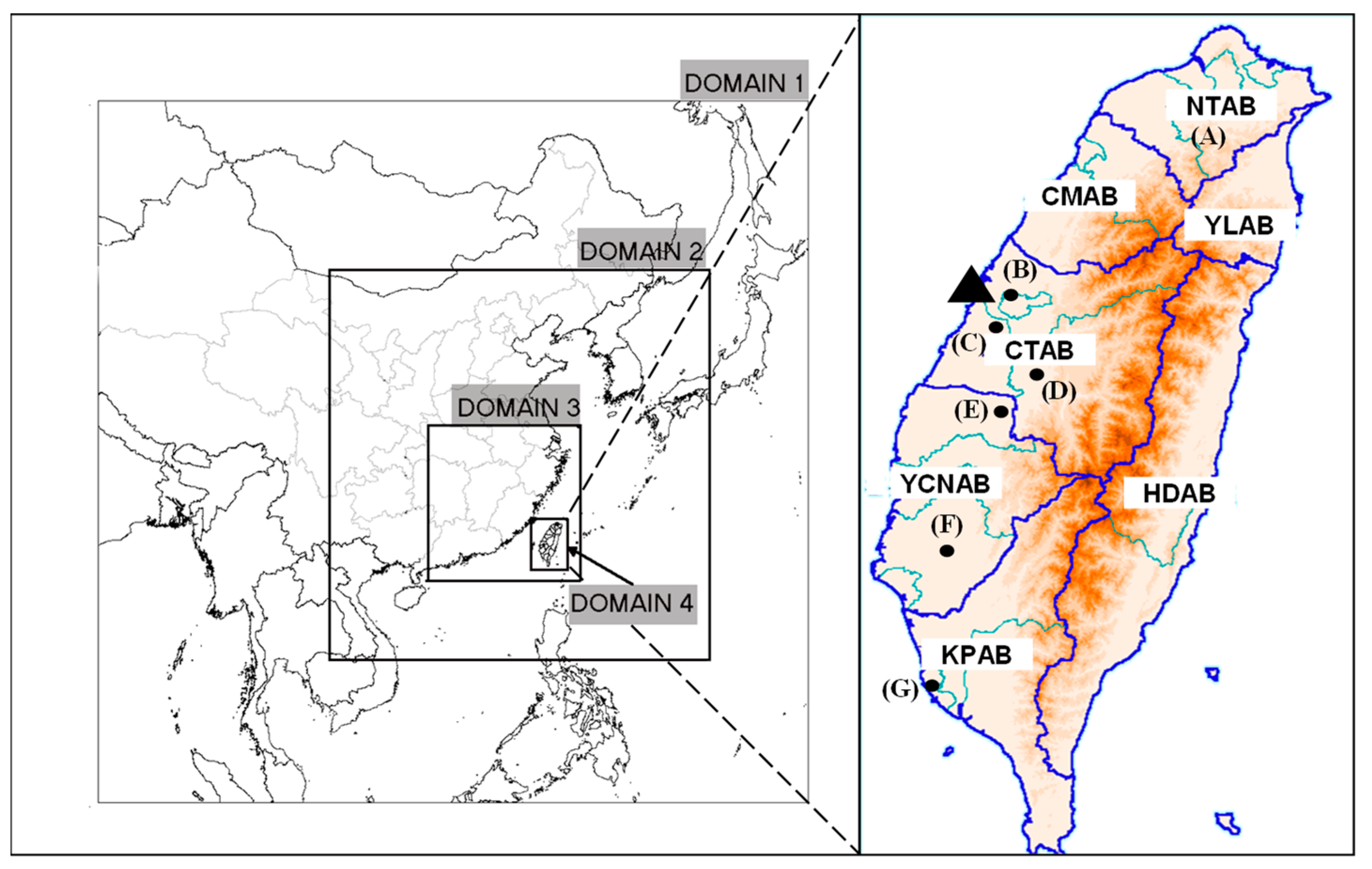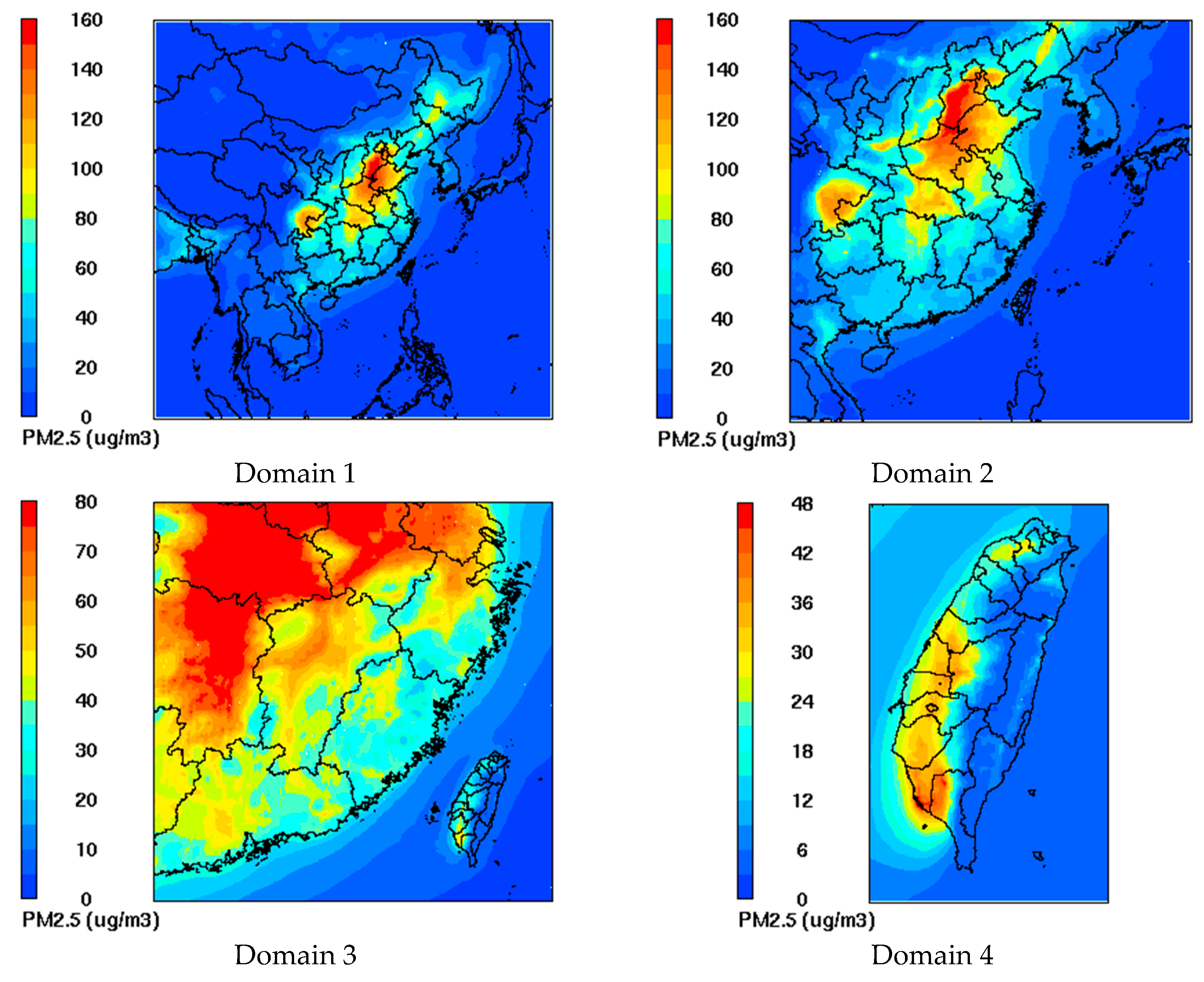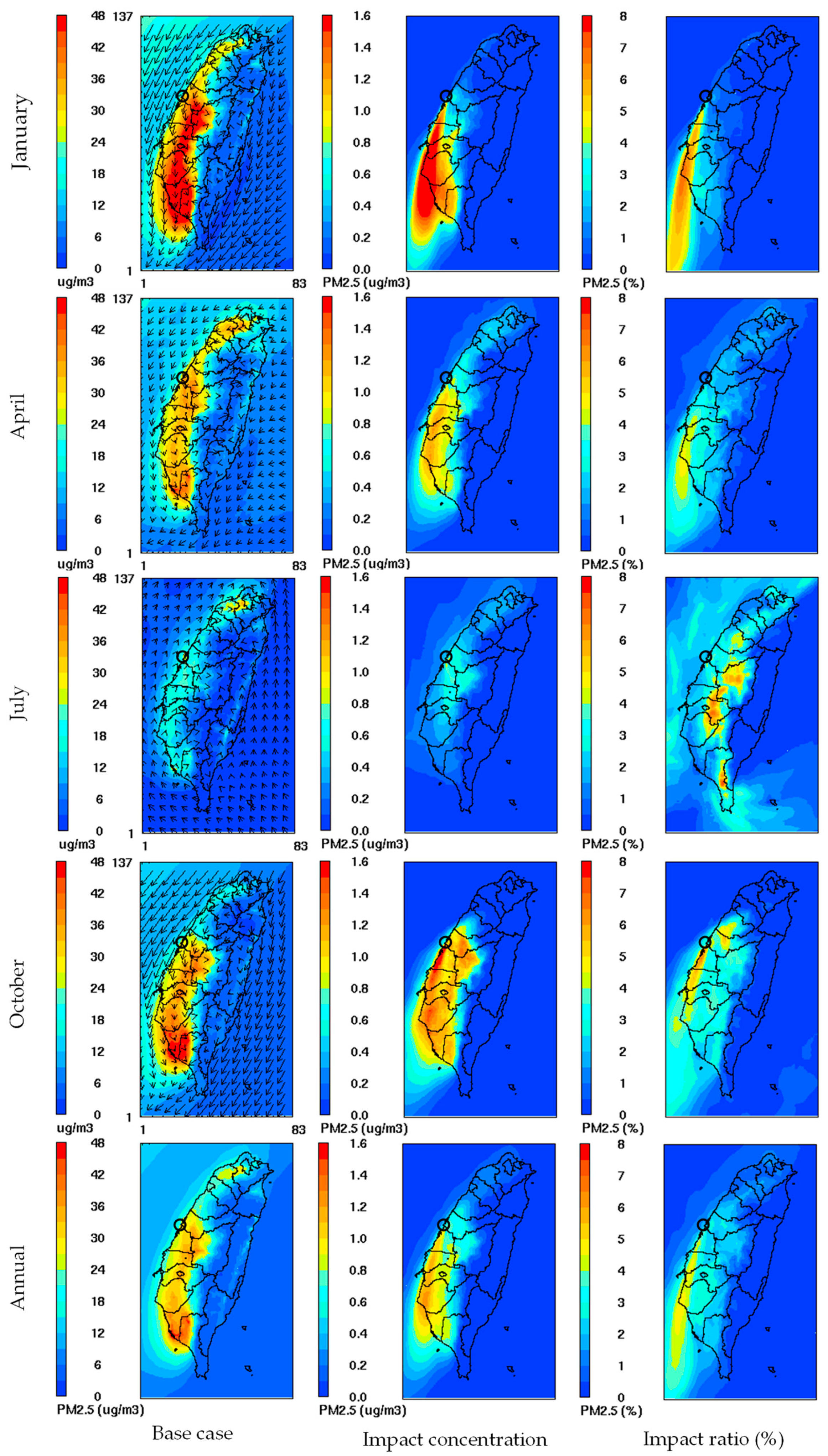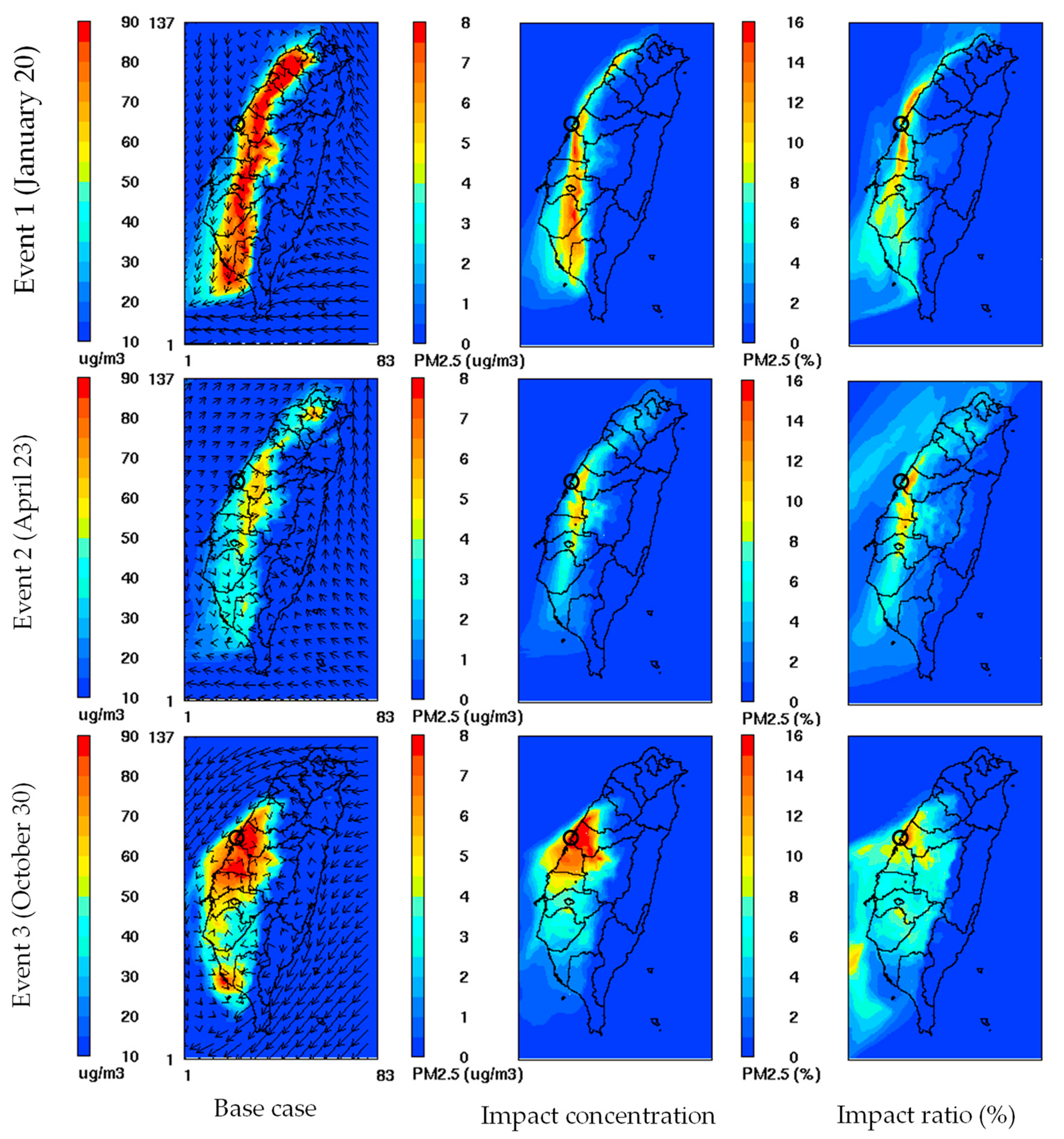Role of an Ultra-Large Coal-Fired Power Plant in PM2.5 Pollution in Taiwan
Abstract
:1. Introduction
2. Materials and Methods
2.1. Taichung Power Plant
2.2. Air Quality Modeling System
2.3. Performance Evaluation
2.4. Simulation of the Effect of TPP’s Emissions
3. Results and Discussion
3.1. Performance Evaluation
3.2. Impact of TPP’s Emissions on the PM2.5 Concentration
3.3. Impact of TPP’s Emissions on Various PM2.5 Pollution Levels
3.4. Analysis of Three PM2.5 Pollution Events
3.5. Potential of TPP’s Load Shedding as an Emergency Response Measure
4. Conclusions
Supplementary Materials
Author Contributions
Funding
Institutional Review Board Statement
Informed Consent Statement
Data Availability Statement
Acknowledgments
Conflicts of Interest
References
- Health Effects Institute (HEI). State of Global Air 2019. Available online: https://www.stateofglobalair.org/sites/default/files/soga_2019_report.pdf (accessed on 26 December 2023).
- World Health Organization Regional Office for Europe. Health Relevance of Particulate Matter from Various Sources: Report on a WHO Workshop, Bonn, Germany 26–27 March 2007; World Health Organization Regional Office for Europe: Copenhagen, Denmark, 2007. [Google Scholar]
- Koplitz, S.N.; Jacob, D.J.; Sulprizio, M.P.; Myllyvirta, L.; Reid, C. Burden of Disease from Rising Coal-Fired Power Plant Emissions in Southeast Asia. Environ. Sci. Technol. 2017, 51, 1467–1476. [Google Scholar] [CrossRef] [PubMed]
- Heo, J.; Adams, P.J.; Gao, H.O. Public Health Costs of Primary PM2.5 and Inorganic PM2.5 Precursor Emissions in the United States. Environ. Sci. Technol. 2016, 50, 6061–6070. [Google Scholar] [CrossRef] [PubMed]
- Wikipedia. Available online: https://en.wikipedia.org/wiki/List_of_coal_power_stations (accessed on 10 July 2023).
- Taiwan Power Company. Taiwan Power Company Sustainability Report 2009; Taiwan Power Company: Taipei, Taiwan, 2009. [Google Scholar]
- TEPA. Regulations of Air Pollution Emergency Response Plan and Warning Notification. In Executive Yuan Gazette; Taiwan Environmental Protection Administration: Taipei, Taiwan, 2009; Volume 28. (In Chinese) [Google Scholar]
- Hwang, D.; Byun, D.W.; Odman, M.T. An automatic differentiation technique for sensitivity analysis of numerical advection schemes in air quality models. Atmos. Environ. 1997, 31, 879–888. [Google Scholar] [CrossRef]
- Yang, Y.J.; Wilkinson, J.; Russell, A. Fast, direct sensitivity analysis of multidimensional photochemical models. Environ. Sci. Technol. 1997, 31, 2859–2868. [Google Scholar] [CrossRef]
- Napelenok, S.L.; Cohan, D.S.; Hu, Y.; Russell, A.G. Decoupled direct 3D sensitivity analysis for particulate matter (DDM-3D/PM). Atmos. Environ. 2006, 40, 6112–6121. [Google Scholar] [CrossRef]
- Kwok, R.H.F.; Napelenok, S.L.; Baker, K.R. Implementation and evaluation of PM2.5 source contribution analysis in a photochemical model. Atmos. Environ. 2013, 80, 398–407. [Google Scholar] [CrossRef]
- Burr, M.J.; Zhang, Y. Source apportionment of fine particulate matter over the Eastern U.S. Part I: Source sensitivity simulations using CMAQ with the Brute Force method. Atmos. Poll. Res. 2011, 2, 300–317. [Google Scholar] [CrossRef]
- Baker, K.R.; Kelly, J.T. Single source impacts estimated with photochemical model source sensitivity and apportionment approaches. Atmos. Environ. 2014, 96, 266–274. [Google Scholar] [CrossRef]
- Koo, B.; Wilson, G.M.; Morris, P.E.; Dunker, A.M.; Yarwood, G. Comparison of source apportionment and sensitivity analysis in a particulate matter air quality model. Environ. Sci. Technol. 2009, 43, 6669–6675. [Google Scholar] [CrossRef]
- Zhang, Y.; Wang, W.; Wu, S.Y.; Wang, K.; Minoura, H.; Wang, Z. Impacts of updated emission inventories on source apportionment of fine particle and ozone over the southeastern U.S. Atmos. Environ. 2014, 88, 133–154. [Google Scholar] [CrossRef]
- Ma, Q.; Chi, S.; Wang, S.; Zhao, B.; Martin, R.V.; Brauer, M.; Cohen, A.; Jiang, J.; Zhou, W.; Hao, J.; et al. Impacts of coal burning on ambient PM2.5 pollution in China. Atmos. Chem. Phys. 2017, 17, 4477–4491. [Google Scholar] [CrossRef]
- Shi, Z.; Li, J.; Huang, L.; Wang, P.; Wu, L.; Ying, Q.; Zhang, H.; Lu, L.; Liu, X.; Liao, H.; et al. Source apportionment of fine particulate matter in China in 2013 using a source-oriented chemical transport model. Sci. Total Environ. 2017, 601–602, 1476–1487. [Google Scholar] [CrossRef] [PubMed]
- Hu, J.; Huang, L.; Chen, M.; He, G.; Zhang, H. Impacts of power generation on air quality in China—Part II: Future scenarios. Resour. Conserv. Recycl. 2017, 121, 115–127. [Google Scholar] [CrossRef]
- Wang, Z.; Pan, L.; Li, Y.; Zhang, D.; Ma, J.; Sun, F.; Xu, W.; Wang, X. Assessment of air quality benefits from the national pollution control policy of thermal power plants in China: A numerical simulation. Atmos. Environ. 2015, 106, 288–304. [Google Scholar] [CrossRef]
- Li, X.; Zhang, Q.; Zhang, Y.; Zheng, B.; Wang, K.; Chen, Y.; He, K. Source contributions of urban PM2.5 in the Beijing–Tianjin–Hebei region: Changes between 2006 and 2013 and relative impacts of emissions and meteorology. Atmos. Environ. 2015, 123, 229–239. [Google Scholar] [CrossRef]
- Huang, L.; Hu, J.; Chen, M.; Zhang, H. Impacts of power generation on air quality in China—Part I: An overview. Resour. Conserv. Recycl. 2017, 121, 103–114. [Google Scholar] [CrossRef]
- Dodla, V.B.R.; Gubbala, C.S.; Desamsetti, S. Atmospheric Dispersion of PM2.5 Precursor Gases from Two Major Thermal Power Plants in Andhra Pradesh, India. Aerosol Air Qual. Res. 2017, 17, 381–393. [Google Scholar] [CrossRef]
- Russell, M.C.; Belle, J.H.; Liu, Y. The impact of three recent coal-fired power plant closings on Pittsburgh air quality: A natural experiment. J. Air Waste Manag. Assoc. 2017, 67, 3–16. [Google Scholar] [CrossRef]
- Mou, D.; Herington, M.; Omoju, O.E. The impacts of coal plants relocation on the concentration of fine particulate matter in China. Ene. Environ. 2016, 27, 741–754. [Google Scholar] [CrossRef]
- He, K.B. Multi-resolution Emission Inventory for China (MEIC): Model framework and 1990–2010 anthropogenic emissions. In Proceedings of the International Global Atmospheric Chemistry Conference, Beijing, China, 17–21 September 2012. [Google Scholar]
- Li, M.; Zhang, Q.; Kurokawa, J.I.; Woo, J.H.; He, K.; Lu, Z.; Ohara, T.; Song, Y.; Streets, D.G.; Carmichael, G.R.; et al. MIX: A mosaic Asian anthropogenic emission inventory under the international collaboration framework of the MICS-Asia and HTAP. Atmos. Chem. Phys. 2017, 17, 935–963. [Google Scholar] [CrossRef]
- Byun, D.W.; Ching, J.K.S. Science Algorithms of the EPA Models-3 Community Multiscale Air Quality (CMAQ) Modeling System; U.S. Environmental Protection Agency: Washington, DC, USA, 1999. [Google Scholar]
- Byun, D.W.; Schere, K.L. Review of the governing equations, computational algorithms, and other components of the models-3 Community Multiscale Air Quality (CMAQ) modeling system. Appl. Mech. Rev. 2006, 59, 51–77. [Google Scholar] [CrossRef]
- Chang, K.H.; Yu, J.Y.; Chen, T.F.; Lin, Y.P. Estimating Taiwan biogenic VOC emission: Leaf energy balance consideration. Atmos. Environ. 2009, 43, 5092–5100. [Google Scholar] [CrossRef]
- Chen, T.F.; Chen, C.H.; Yu, J.Y.; Lin, Y.B.; Chang, K.H. Estimation of biogenic VOC emissions in East Asia with new emission factors and leaf energy balance considerations. J. Innov. Technol. 2020, 2, 61–72. [Google Scholar]
- Jiang, W.; Smyth, S.; Giroux, E.; Roth, H.; Yin, D. Differences between CMAQ fine mode particle and PM2.5 concentrations and their impact on model performance evaluation in the lower Fraser valley. Atmos. Environ. 2006, 40, 4973–4985. [Google Scholar] [CrossRef]
- Boylan, J.W.; Russell, A.G. PM and light extinction model performance metrics, goals, and criteria for three-dimensional air quality models. Atmos. Environ. 2006, 40, 4946–4959. [Google Scholar] [CrossRef]
- Willmott, C.J. On the validation of models. Phys. Geogr. 1981, 2, 184–194. [Google Scholar] [CrossRef]
- Stelson, A.W.; Seinfeld, J.H. Relative humidity and temperature dependence of the ammonium nitrate dissociation constant. Atmos. Environ. 1982, 16, 983–992. [Google Scholar] [CrossRef]




| Source | PM2.5 | SOX | NOX | NMHC | NH3 |
|---|---|---|---|---|---|
| China 1 | 1212 | 2839 | 2849 | 2292 | 955 |
| Japan 2 | 8.1 | 70.8 | 191.4 | 117.8 | 47.9 |
| Korea 2 | 8.7 | 41.8 | 106.2 | 85.1 | 19.0 |
| Taiwan 3 | 7.72 | 11.69 | 39.94 | 45.72 | 1.89 |
| Taichung Power Plant (TPP) 3 | 0.12 | 1.49 | 2.32 | 0.0003 | - |
| Total power plants 3 | 0.30 | 4.19 | 6.91 | 0.0049 | - |
| TPP vs. Taiwan (%) | 1.6 | 12.7 | 5.8 | 0.0 | - |
| TPP vs. Total power plants (%) | 41.9 | 35.5 | 33.5 | 6.0 | - |
| Sim | Obs | MFB | MFE | IOA | R | |
|---|---|---|---|---|---|---|
| PM2.5 | µg/m3 | µg/m3 | % | % | ||
| January | 32.2 | 35.2 | −22.0 | 42.4 | 0.8 | 0.8 |
| April | 30.3 | 35.3 | −23.6 | 41.3 | 0.7 | 0.6 |
| July | 20.1 | 18.7 | −4.3 | 42.4 | 0.7 | 0.6 |
| October | 27.2 | 31.1 | −32.5 | 47.9 | 0.7 | 0.7 |
| Annual | 27.5 | 30.1 | −20.6 | 43.5 | 0.7 | 0.7 |
| NO2 | ppb | ppb | % | % | ||
| January | 15.7 | 17.6 | −20.6 | 36.2 | 0.7 | 0.8 |
| April | 16.4 | 16.9 | −8.7 | 34.4 | 0.7 | 0.7 |
| July | 16.0 | 10.6 | 36.1 | 46.2 | 0.5 | 0.8 |
| October | 13.9 | 12.7 | −4.8 | 39.2 | 0.6 | 0.7 |
| Annual | 15.5 | 14.4 | 0.5 | 39.0 | 0.6 | 0.7 |
| SO2 | ppb | ppb | % | % | ||
| January | 2.7 | 3.4 | −42.8 | 60.0 | 0.6 | 0.6 |
| April | 2.6 | 3.4 | −37.8 | 55.7 | 0.6 | 0.6 |
| July | 2.2 | 3.4 | −60.4 | 71.0 | 0.5 | 0.6 |
| October | 2.8 | 3.2 | −49.3 | 66.2 | 0.5 | 0.6 |
| Annual | 2.6 | 3.3 | −47.6 | 63.3 | 0.6 | 0.6 |
| Air Basin | Medium PM2.5 Level (36–54 µg/m3) | High PM2.5 Level (55–70 µg/m3) | Serious PM2.5 Level (>70 µg/m3) | Annual Avg. | ||||
|---|---|---|---|---|---|---|---|---|
| Base µg/m3 | Impact µg/m3 (%) | Base µg/m3 | Impact µg/m3 (%) | Base µg/m3 | Impact µg/m3 (%) | Base µg/m3 | Impact µg/m3 (%) | |
| NTAB | 42.2 | 0.4 (1.0) | 61.7 | 0.9 (1.4) | 79.4 | 1.4 (1.8) | 21.7 | 0.2 (0.8) |
| CMAB | 43.0 | 0.6 (1.3) | 59.7 | 1.6 (2.6) | 87.1 | 1.8 (2.0) | 22.3 | 0.3 (1.3) |
| CTAB | 43.6 | 1.0 (2.2) | 61.0 | 1.4 (2.3) | 89.1 | 3.7 (4.2) | 30.6 | 0.8 (2.4) |
| YCNAB | 43.0 | 1.5 (3.4) | 61.9 | 1.9 (3.1) | 84.1 | 2.4 (2.8) | 29.0 | 1.0 (3.3) |
| KPAB | 45.0 | 1.0 (2.2) | 61.4 | 1.5 (2.5) | 86.8 | 1.7 (2.0) | 39.5 | 0.8 (2.0) |
| YLAB | 41.2 | 0.1 (0.2) | - | - | - | - | 12.0 | <0.1 (0.2) |
| HTAB | 36.0 | <0.1 (0.0) | - | - | - | - | 8.7 | <0.1 (0.1) |
| Taiwan | 43.5 | 0.9 (2.1) | 61.4 | 1.5 (2.4) | 86.6 | 2.2 (2.6) | 27.0 | 0.5 (1.9) |
| Month | Medium PM2.5 Level (36–54 µg/m3) | High PM2.5 Level (55–70 µg/m3) | Serious PM2.5 Level (>70 µg/m3) | Monthly Avg. | ||||||||
|---|---|---|---|---|---|---|---|---|---|---|---|---|
| Base µg/m3 | Impact µg/m3 (%) | Base µg/m3 | Impact µg/m3 (%) | Base µg/m3 | Impact µg/m3 (%) | Base µg/m3 | Impact µg/m3 (%) | |||||
| January | 43.8 | 0.6 | (1.3) | 61.9 | 1.3 | (2.1) | 86.1 | 1.8 | (1.8) | 33.0 | 0.6 | (1.7) |
| April | 43.5 | 1.0 | (2.3) | 61.3 | 1.3 | (2.0) | 80.1 | 1.5 | (0.8) | 30.4 | 0.6 | (1.9) |
| July | 41.5 | 0.8 | (2.0) | 59.8 | 1.6 | (2.7) | 83.7 | 0.7 | (0.7) | 18.3 | 0.3 | (1.7) |
| October | 44.2 | 1.1 | (2.6) | 61.0 | 1.9 | (3.1) | 90.3 | 3.7 | (4.1) | 26.5 | 0.6 | (2.3) |
| Annual | 43.5 | 0.9 | (2.1) | 61.4 | 1.5 | (2.4) | 86.6 | 2.2 | (2.6) | 27.0 | 0.5 | (1.9) |
| Site Name | Event 1 (20 January) | Event 2 (23 April) | Event 3 (30 October) | |||
|---|---|---|---|---|---|---|
| Base µg/m3 | Impact µg/m3 (%) | Base µg/m3 | Impact µg/m3 (%) | Base µg/m3 | Impact µg/m3 (%) | |
| Banqiao | 63.7 | 0.5 (0.7) | 67.9 | 1.7 (2.5) | 9.9 | 0.0 (0.0) |
| Xitun | 75.0 | 4.3 (5.8) | 51.2 | 4.3 (8.4) | 99.8 | 10.5 (10.5) |
| Changhua | 58.0 | 6.3 (10.9) | 45.0 | 4.9 (10.9) | 86.8 | 7.4 (8.5) |
| Nantou | 74.7 | 2.3 (3.1) | 56.9 | 3.3 (5.7) | 77.3 | 5.2 (6.8) |
| Douliu | 66.7 | 5.6 (8.3) | 45.8 | 5.1 (11.0) | 73.8 | 4.3 (5.8) |
| Shanhua | 48.4 | 3.5 (7.3) | 37.3 | 2.1 (5.5) | 52.8 | 2.9 (5.6) |
| Qianzhen | 83.5 | 3.9 (4.6) | 45.6 | 1.6 (3.4) | 75.8 | 1.5 (1.9) |
Disclaimer/Publisher’s Note: The statements, opinions and data contained in all publications are solely those of the individual author(s) and contributor(s) and not of MDPI and/or the editor(s). MDPI and/or the editor(s) disclaim responsibility for any injury to people or property resulting from any ideas, methods, instructions or products referred to in the content. |
© 2023 by the authors. Licensee MDPI, Basel, Switzerland. This article is an open access article distributed under the terms and conditions of the Creative Commons Attribution (CC BY) license (https://creativecommons.org/licenses/by/4.0/).
Share and Cite
Tsai, C.-Y.; Chen, T.-F.; Chang, K.-H. Role of an Ultra-Large Coal-Fired Power Plant in PM2.5 Pollution in Taiwan. Atmosphere 2024, 15, 56. https://doi.org/10.3390/atmos15010056
Tsai C-Y, Chen T-F, Chang K-H. Role of an Ultra-Large Coal-Fired Power Plant in PM2.5 Pollution in Taiwan. Atmosphere. 2024; 15(1):56. https://doi.org/10.3390/atmos15010056
Chicago/Turabian StyleTsai, Chang-You, Tu-Fu Chen, and Ken-Hui Chang. 2024. "Role of an Ultra-Large Coal-Fired Power Plant in PM2.5 Pollution in Taiwan" Atmosphere 15, no. 1: 56. https://doi.org/10.3390/atmos15010056




